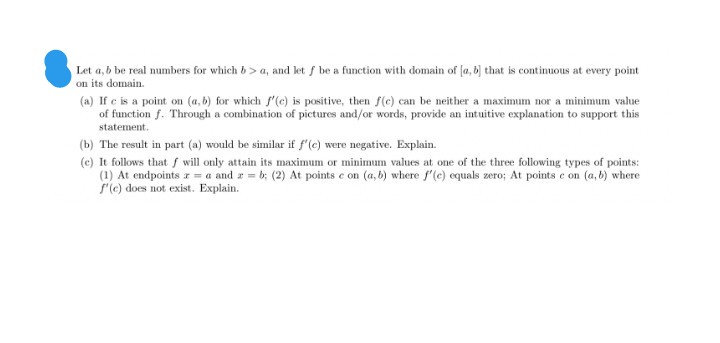Let a, b be real numbers for which b> a, and let f be a function with domain of (a, b) that is continuous at every point on its domain. (a) If e is a point on (a, b) for which f'(e) is positive, then f(e) can be neither a maximum nor a minimum value of function f. Through a combination of pictures and/or words, provide an intuitive explanation to support this statement. (b) The result in part (a) would be similar if f'(c) were negative. Explain. (c) It follows that f will only attain its maximum or minimum values at one of the three following types of points: (1) At endpoints z = a and z = b; (2) At points e on (a, b) where r(e) equals zero; At points e on (a, b) where r(e) does not exist. Explain.
Let a, b be real numbers for which b> a, and let f be a function with domain of (a, b) that is continuous at every point on its domain. (a) If e is a point on (a, b) for which f'(e) is positive, then f(e) can be neither a maximum nor a minimum value of function f. Through a combination of pictures and/or words, provide an intuitive explanation to support this statement. (b) The result in part (a) would be similar if f'(c) were negative. Explain. (c) It follows that f will only attain its maximum or minimum values at one of the three following types of points: (1) At endpoints z = a and z = b; (2) At points e on (a, b) where r(e) equals zero; At points e on (a, b) where r(e) does not exist. Explain.
College Algebra (MindTap Course List)
12th Edition
ISBN:9781305652231
Author:R. David Gustafson, Jeff Hughes
Publisher:R. David Gustafson, Jeff Hughes
Chapter3: Functions
Section3.3: More On Functions; Piecewise-defined Functions
Problem 99E: Determine if the statemment is true or false. If the statement is false, then correct it and make it...
Related questions
Question

Transcribed Image Text:Let a, b be real numbers for which b> a, and let f be a function with domain of (a, b) that is continuous at every point
on its domain.
(a) If e is a point on (a, b) for which f'(e) is positive, then f(e) can be neither a maximum nor a minimum value
of function f. Through a combination of pictures and/or words, provide an intuitive explanation to support this
statement.
(b) The result in part (a) would be similar if f'(e) were negative. Explain.
(c) It follows that fs will only attain its maximum or minimum values at one of the three following types of points:
(1) At endpoints r = a and r = b; (2) At points e on (a,b) where f(e) equals zero; At points e on (a, b) where
r(c) does not exist. Explain.
Expert Solution
This question has been solved!
Explore an expertly crafted, step-by-step solution for a thorough understanding of key concepts.
Step by step
Solved in 2 steps with 2 images

Recommended textbooks for you

College Algebra (MindTap Course List)
Algebra
ISBN:
9781305652231
Author:
R. David Gustafson, Jeff Hughes
Publisher:
Cengage Learning

Algebra & Trigonometry with Analytic Geometry
Algebra
ISBN:
9781133382119
Author:
Swokowski
Publisher:
Cengage


College Algebra (MindTap Course List)
Algebra
ISBN:
9781305652231
Author:
R. David Gustafson, Jeff Hughes
Publisher:
Cengage Learning

Algebra & Trigonometry with Analytic Geometry
Algebra
ISBN:
9781133382119
Author:
Swokowski
Publisher:
Cengage


College Algebra
Algebra
ISBN:
9781305115545
Author:
James Stewart, Lothar Redlin, Saleem Watson
Publisher:
Cengage Learning